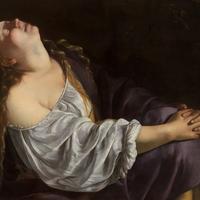More about Judith Slaying Holofernes

Contributor
Artemisia Gentileschi wasn’t the only artist to paint Judith’s gory beheading of Holofernes, but her version of this tough-as-nails lady of the Bible is the toughest of them all.
Just take a look at Caravaggio's dainty, white-frocked Judith who looks worried about getting blood on herself; Rubens’s interpretation of her as a half-naked sexpot; or the disconcertingly blasé way that Cristofano Allori’s super-chilled-out Judith holds out Holofernes’s recently-severed head and you’ll see just what I mean. Unlike all those other Judiths, this one means business. The look on her face says, “Well, someone had to do it,” and she is completely unflinching as carries out her unsavory task.
According to the story—which is apocryphal according to Jewish and Protestant traditions but included in the Catholic Bible—Judith was a widow from the city of Bethulia, which had recently been besieged by an Assyrian army led by Holofernes. In order to save her city, Judith curled her hair, donned her finest clothes, and gained entrance into the enemy camp by pretending to have insider information that would secure a victory for Holofernes. Enchanted by her beauty, Holofernes invited her over for dinner with a plan to seduce her, but ended up getting blackout drunk instead. It was then that Judith saw her chance: with Holofernes passed out, she seized his sword and cut off his head, dropping it into a bag held by her maidservant so they could bring it back to Bethulia and show her people that he was dead.
The very real feelings of determination and rage one can feel emanating from this particular version of Judith (and the fact that Gentileschi returned to the subject many times over the course of her career) might have something to do with Gentileschi’s own personal identification with her. At the age of 17—about a year before she completed this painting—she was raped by a close friend of her father, the artist Agostino Tassi. Many people read this work as Gentileschi’s expression of rage against Tassi. Gentileschi and her father were, depressingly, only able to press charges because she’d been a virgin when Tassi raped her, and during the long and grueling trial that followed, Gentileschi was tortured with thumbscrews—supposedly to prove the veracity of her story, although the same treatment was (surprise, surprise) not extended to her rapist. During the trial, it was revealed that raping Gentileschi was far from the first crime Tassi had committed; he’d also raped his sister-and-law and plotted the murder of his wife, who had been missing for some time. At the end of the trial, Tassi was exiled from Rome for a period of five years, although the punishment was apparently never enforced (again, no big surprises there). In the end it was Gentileschi who left the city, moving to Florence with a minor painter her father had arranged for her to marry. After her move, Gentileschi went on to achieve tremendous success, becoming the first woman to join the Accademia delle Arti del Disegno (Academy of the Arts of Drawing) and working as a court painter to the famed House of Medici. During this period, her father, the artist Orazio Gentileschi, wrote glowingly about her in a letter requesting patronage from the grand duchess of Tuscany: “In three years [she] has become so skilled I can venture to say that today she has no peer; indeed she has produced works which demonstrate a level of understanding which perhaps even the principal masters of the profession have not attained.”
During her trial, Gentileschi described in vivid detail her struggle against Tassi and her attempts to stave him off with a knife. According to her testimony, she had been minding her own business painting when Tassi burst into the room shouting, “Not so much painting, not so much painting!,” throwing the palette and brushes Gentileschi had been using onto the floor in an act disturbingly resonant with general attitudes toward women painting in the 17th century. Gentileschi also recounted the sense of betrayal she had felt when she was abandoned by a female chaperone, Tuzia Medaglia, who left Gentileschi alone with Tassi even though Gentileschi asked her not to. “I don’t want to stay here and argue. I want to go about my own business,” was Medaglia’s cold response to Gentileschi’s request, and she proceeded to go upstairs and ignore Gentileschi’s screams for help. This aspect of Gentileschi’s testimony casts her choice to have the maidservant actively help Judith kill Holofernes in this painting in an especially poignant light. While most interpretations of the story show Judith’s maidservant, usually a much older woman, waiting on the sidelines while Judith does the dirty deed herself, Gentileschi reimagines the two women actively working together to protect their city from the Assyrian general. While the painting could, as many critics have argued, be Gentileschi’s way of getting what revenge she could on Tassi, perhaps it is even more than that a depiction of the strength that women could have if they only worked together, instead of taking Tazia Medaglia’s stance of “going about one’s business” and, in doing so, enabling men like Tassi to continue to act with entitlement and violence towards other women. The powerful arms and ease with which the women hold Holofernes down seem to say, “See? Look how strong we could be if we just worked together!”
Sources
- Camara, Esperança. “Artemisia Gentileschi, Judith Slaying Holofernes.” Smarthistory, July 19, 2015. https://smarthistory.org/gentileschi-judith-slaying-holofernes/.
- Cascone, Sarah. “Newly Beloved Old Master Artemisia Gentileschi’s Life Story is Dramatic Enough for a TV Series—and Soon, It Will Be the Subject of One,” Artnet News, October 15, 2020, https://news.artnet.com/art-world/artemisa-television-show-191571
- Jones, Christopher P. “How to Read Paintings: Judith Slaying Holofernes by Artemisia Gentileschi.” Medium, October 15, 2020. https://medium.com/thinksheet/how-to-read-paintings-judith-slaying-holo….
- “Judith’s Story.” Google Arts & Culture. Accessed July 15, 2021. https://artsandculture.google.com/story/judith-39-s-story-the-national-….
- Klowden, Tanya. “400 years ago, an Italian artist risked everything to publicly accuse her rapist.” Quartz, October 7, 2018. https://qz.com/quartzy/1413735/400-years-ago-an-italian-artist-risked-e….
- Murray, Jenni. “The Vengeance of Artemisia Gentileschi.” Lithub, October 12, 2018. https://lithub.com/the-vengeance-of-artemisia-gentileschi/.
Featured Content
Here is what Wikipedia says about Judith Slaying Holofernes (Artemisia Gentileschi, Naples)
Judith Slaying Holofernes is a painting by the Italian early Baroque artist Artemisia Gentileschi, completed in 1612–13 and now at the Museo Capodimonte, Naples, Italy.
The picture is considered one of her iconic works. The canvas shows Judith beheading Holofernes. The subject takes an episode from the deuterocanonical Book of Judith in the Old Testament, which recounts the assassination of the Assyrian general Holofernes by the Israelite heroine Judith. The painting shows the moment when Judith, helped by her maidservant Abra, beheads the general after he has fallen asleep in a drunken stupor. She painted a second version (now in the Uffizi, Florence) somewhere between 1613 and 1621.
Early feminist critics interpreted the painting as a form of visual revenge following Gentileschi's rape by Agostino Tassi in 1611; similarly many other art historians see the painting in the context of her achievement in portraying strong women.
Check out the full Wikipedia article about Judith Slaying Holofernes (Artemisia Gentileschi, Naples)













